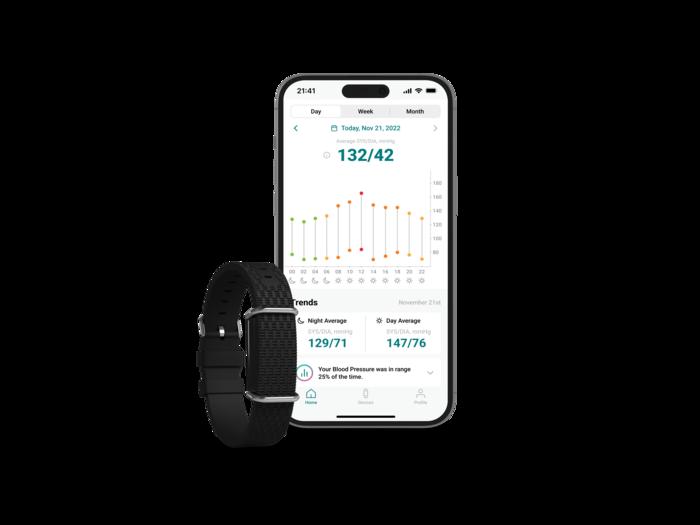A study led by a Brigham investigator evaluated a novel device that automatically measures blood pressure at the wrist, generating hundreds of readings within days that may help clinicians determine cardiovascular risk and improve hypertension care

Credit: Aktiia SA
A study led by a Brigham investigator evaluated a novel device that automatically measures blood pressure at the wrist, generating hundreds of readings within days that may help clinicians determine cardiovascular risk and improve hypertension care
High blood pressure, the leading risk factor for death worldwide, is present in one in every two adults. Only one-quarter of individuals with hypertension have their blood pressure under control, highlighting the need for innovative strategies for blood pressure management. A study led by an investigator from Brigham and Women’s Hospital, a founding member of the Mass General Brigham healthcare system, evaluated a cuffless monitor that uses optical sensors to record blood pressure continually and efficiently, without disruption to the patient. The study, published in Frontiers in Medicine, highlights promising advancements in hypertension diagnosis, risk assessment and management that may be enabled by use of cuffless devices.
“The successful management of hypertension depends on patients being able to take blood pressure measurements easily and reliably outside of the traditional doctor’s office setting,” said corresponding author Naomi Fisher, MD, of the Division of Endocrinology, Diabetes and Hypertension at Brigham and Women’s Hospital. “Cuffless devices have the potential to revolutionize hypertension management. They provide many more readings than traditional devices, during both the day and night, which can help confirm the diagnosis of hypertension and guide medication titration.”
Medical guidelines increasingly recommend the incorporation of at-home blood pressure monitoring into hypertension diagnosis and management. This is because isolated blood pressure readings taken at a clinician’s office may be inaccurate: for some, blood pressure tends to rise in medical settings (“white coat hypertension”) while others have normal blood pressure during examination despite hypertensive readings at home (“masked hypertension”).
Time-in-target-range (TTR) describes how often a patient’s blood pressure is in the normal range, and it is emerging as a promising metric of cardiovascular risk. But TTR requires more frequent blood pressure readings that can feasibly be obtained by patients with traditional blood pressure cuffs, which can be inconvenient, burdensome and sometimes uncomfortable for patients.
Fisher, who designed and led the study, collaborated with co-authors from Aktiia SA, a Swiss biotechnology company, to analyze over 2.2 million blood pressure readings from 5,189 subjects in Europe and the U.K. who wore a cuffless wrist monitor manufactured by Aktiia. On average, the Aktiia device collected 29 readings per day, a substantial increase from the number of blood pressure readings patients typically take with home devices (guidelines recommend four per day, which is more than most patients measure). Over a 15-day period, the researchers obtained an average of 434 readings from each patient.
By calculating TTR over a 15-day period, the researchers were able to risk stratify participants by percentage of readings in target range and compare these classifications to those generated via traditional measurement patterns, using either 24-hour or week-long daytime monitoring schedules. They found that the traditional methods misclassified 26 and 45 percent of subjects, respectively, compared to the reference TTR. They determined that continual monitoring for seven days is required to obtain 90 percent or greater accuracy in hypertension risk classification, a frequency of measurement that may only be possible with cuffless monitors.
Though the cuffless device studied here has not been approved by the U.S. Food and Drug Administration, it has been validated in multiple studies and is available for over-the-counter purchase in Europe and the U.K. Work to evaluate and set standards for such devices in the U.S. is ongoing.
“For the first time, by using a cuffless device, we can collect continual out-of-office blood pressure readings and use these data to calculate a new metric, time-in-target-range, which shows great promise as a predictor of risk,” Fisher said. “The use of cuffless devices could create a shift in the paradigm of blood pressure monitoring and hypertension management.”
Authorship: Fisher’s co-authors on the paper include Tiago P. Almeida, David Perruchoud, Jay Shah, and Josep Sola.
Disclosures: Fisher serves as a consultant for Aktiia SA. Almeida, Perruchoud, Shah, and Sola are employees of Aktiia SA.
Funding: No financial support was received for this research.
Paper cited: Fisher, ND et al. “Optimizing Time-in-Target-Range Assessment for Blood Pressure: Insights from a Large-Scale Study with Continual Cuffless Monitoring” Frontiers in Medicine DOI: 10.3389/fmed.2024.1396962
###
Journal
Frontiers in Medicine
Method of Research
Observational study
Subject of Research
People
Article Title
Optimizing Time-in-Target-Range Assessment for Blood Pressure: Insights from a Large-Scale Study with Continual Cuffless Monitoring
Article Publication Date
26-Jun-2024
COI Statement
Fisher serves as a consultant for Aktiia SA. Almeida, Perruchoud, Shah, and Sola are employees of Aktiia SA.



